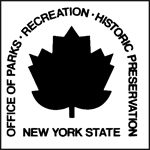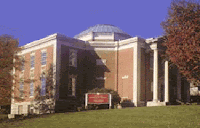 The New York State Board for Historic Preservation recommended the addition of 28 properties to the State and National Registers of Historic Places, including such nationally significant sites as the National Grid Building in downtown Syracuse, the Bird Homestead in Westchester County, and a French and Indian War archaeological site in Saratoga County.
The New York State Board for Historic Preservation recommended the addition of 28 properties to the State and National Registers of Historic Places, including such nationally significant sites as the National Grid Building in downtown Syracuse, the Bird Homestead in Westchester County, and a French and Indian War archaeological site in Saratoga County.
State and National Historic Register listing can assist property owners in revitalizing the structures, making them eligible for various public preservation programs and services, such as matching state grants and state and federal historic rehabilitation tax credits. The State and National Registers are the official lists of buildings, structures, districts, landscapes, objects and sites significant in the history, architecture, archeology and culture of New York State and the nation. There are 90,000 historic buildings, structures and sites throughout the state listed on the National Register of Historic Places, individually or as components of historic districts. Property owners, municipalities and organizations from communities throughout the state sponsored the nominations.
Once the recommendations are approved by the state historic preservation officer, the properties are listed on the New York State Register of Historic Places and then nominated to the National Register of Historic Places, where they are reviewed and, once approved, entered on the National Register.
STATE REVIEW BOARD RECOMMENDATIONS
Broome County
Vestal Central School, Vestal – a distinctive 1939 Art Deco school built as part of the town’s centralization program to accommodate a fast-growing population and designed by one of the region’s prestigious architectural firms.
Chemung County
John Brand Jr. House (Parkside Apartments), Elmira – a distinguished and largely intact example of a large-scale Queen Anne/Shingle style residence built around 1890.
William S. Gerity House, Elmira – a large-scale Queen Anne/Eastlake style residence built around 1880 that is likely the work of Thomas Gerity, William’s father and a prominent contractor responsible for many of Elmira’s major buildings.
Erie County
Alling & Corey Warehouse, Buffalo – the 1910 building is an excellent and early Buffalo example of the type of reinforced concrete industrial buildings that came to be known as the “Daylight Factory.”
Buffalo Trunk Manufacturing Building, Buffalo —- a 1901 “slow-burn” masonry and wood factory that embodies the characteristics of a turn-of- the-twentieth-century industrial building constructed in manner to safeguard against the ravages of factory fires.
The Kamman Building, Building – the 1883 commercial building is a rare survivor of the Hydraulics/Larkin Neighborhood, one of Buffalo’s earliest, distinct neighborhoods, and Buffalo’s first manufacturing district, founded in the 1820s, which was an important self-contained neighborhood with a mix of industrial, commercial and residential architecture through the mid-20th century.
Essex County
Willsboro School, Willsboro – the 1927 Neoclassical style school building retains a high level of its original standardized school building design of the period.
Fulton County
Oppenheim and St. Johnsville Union Society Church, Crum Creek – a highly intact, representative example of vernacular religious architecture in rural Fulton County constructed in 1853.
Herkimer County
Overlook, Little Falls – the High Victorian house was built in 1889 for David H. Burrell, whose dairy industry inventions and innovations in the late nineteenth and early twentieth centuries helped make Little Falls one of the most important cheese-producing centers in the United States.
Kings County
The Jewish Center of Kings Highway, Midwood – built in 1928-30, the Neo-Classical synagogue dates from a period when Brooklyn had emerged as one of the world’s major Jewish population centers and combines religious facilities with classrooms, a social hall, and a gymnasium, as was characteristic of the “Jewish Center” movement.
Kingsway Jewish Center, Midwood – built in 1951, it is an example of a post-World War II modern synagogue in Brooklyn.
Young Israel of Flatbush – built in 1925-29 for an Orthodox Jewish congregation, the Moorish Revival synagogue reflects an international trend to adapt the more ‘Eastern’ Moorish-style to synagogue design.
Monroe County
First Baptist Church of Mumford – a largely intact representative example of vernacular Greek Revival style church architecture built in 1852 for a rural Protestant congregation.
Teoronto Block Historic District, Rochester – the well-preserved examples of mid-19th century commercial architecture reflect the city’s rapid growth as a mill center and Erie Canal boomtown.
Onondaga County
The Niagara Hudson Building (National Grid Building), Syracuse – completed in 1932, the headquarters for then the nation’s largest electric utility company is an outstanding example of Art Deco architecture and a symbol of the Age of Electricity.
Onondaga Highlands-Swaneola Heights Historic District, Syracuse – a turn-of-the-twentieth-century subdivision where the rolling topography, uniform building setback, and popular residential styles form a cohesive neighborhood that retains its architectural integrity.
Orange County
Newburgh Colored Burial Ground, Newburgh – an archeological site with great potential to yield information about the city’s mid-19th century African-American population.
Walsh-Havemeyer House, New Windsor – the Greek Revival influenced house was built around 1835 for a family who operated one of the region’s early industries on the adjacent Quassaic Creek.
Lower Dock Hill Road Stone Arch Bridge, Cornwall-on-Hudson – an early example of 19th century stone arch bridge construction.
St. Lawrence County
First Congregational Church of Madrid – the 1890 Eastlake-style church building has been the spiritual and social center for the oldest congregational church society in St. Lawrence County.
Sunday Rock, Colton – public outcry has twice saved the 64,000 pound glacial boulder, a natural traveler’s landmark for centuries, from demolition to make way for construction of State Highway 56.
Saratoga County
The Royal Blockhouse – built in 1758 in the vicinity of Fort Edward, the Royal Blockhouse was a key part of one of the largest British military complexes in North America at the beginning of the French and Indian War, and its remnants are likely to yield a wealth of archaeological information about 18th century military practices.
Schenectady County
Ronsendale Common School, Niskayuna – the rural school building, which served students from its construction in the 1850s until 1915, retains an exceptionally high degree of architectural integrity in a rural setting despite rapid commercial and residential development in the town.
Steuben County
Atlanta Presbyterian Church, Atlanta – a well-preserved example of Queen Anne-style church architecture which reflects Atlanta’s late-nineteenth century prosperity as an important local transportation, food processing and commercial center.
Ulster County
Lattingtown Baptist Church, Marlborough – Constructed circa 1810, in what was the original center of activity for the town of Marlborough, the Federal period meeting house style church is closely associated with the settlement, growth and development of this riverside town.
Warren County
Methodist Episcopal Church, Stony Creek – Built in 1856-59, the building is a good e
xample of wood frame church architecture in a small Adirondack cross-roads settlement.
Westchester County
The Bird Homestead, Rye – the 1835 Greek Revival was the home of Henry Bird and sons Roland T. Bird and Junius Bird, three prominent scientists who made discoveries of national significance in the fields of entomology, paleontology, and archeology respectively, and were leading members of the American Museum of Natural History.
Tuckahoe High School, Tuckahoe – the 1930-31 school is an outstanding example of Art Deco public architecture, reflecting the importance of education to its suburban community.
This is the rest of the post





